
– By Aishani Mishra
– Intern, IPPCS’21
We live in a world where gender has played a crucial role in determining not only our stand in personal, social and political domain, but also our access to resources and ultimately, positions of power. It is a sad reality that gender notions have always functioned on the lines of patriarchy and hence, the narratives generated in all forms of our existence, including International Relations and Foreign Policy, are also gender mainstreamed into systemic and global subordination of women. However, very recently, with the evolution of a feminist discipline in IR, things have been changing.
With a radical shift in its foreign policy, Sweden became the first nation to publicly adopt what it termed as “a feminist foreign policy” in 2015. This historic move came in the face of the promotion of gender equality and women’s rights as being pillars of the diplomatic stance of the welfare state. Elaborating on the structure of a feminist foreign policy, Foreign Minister Margot Wallstrom stated in an interview with the New Yorker in March 2015 that the policy meant “standing against the systematic and global subordination of women.” The foreign is strongly informed by the Security Council Resolution 1325 agenda on women, peace, and security (WPS) as a normative framework for foreign and security policies.
However, the aim of gender equality and guaranteeing human rights can also be done via other incentives and additional policies, why to adopt the ‘specific feminist foreign policy’? What does it actually do?
Let’s consider the data first: On a global level, around 90 percent of heads of state and governments are men, only 15 percent of all ambassadors are women. When talking about India, in 75 years of independence, we have had just 2 female External Affairs Ministers; which is not even 10% representation and just 3 women serving as foreign secretaries of the state. On a world scale, only 2.5 percent of chief mediators are women, as are only 9 percent of peace negotiators and only 4 percent of signatories to peace accords.
Now, let’s understand how the feminist foreign policy functions in the face of such injustices to create a change. As argued in a paper published in EIA, the adoption of a feminist foreign policy has a two-pronged approach. On one hand, by adopting the “f-word”, it elevates politics towards topics that seek to renegotiate and challenge power hierarchies and gendered institutions. On the other hand, it contains a normative reorientation of foreign policy that is guided by an ethically informed framework based on broad cosmopolitan norms of global justice and peace.
The Swedish government has framed their policy on the pillars of 3 Rs: Representation, Rights, and Reallocation. Sweden seeks to promote women’s representation and participation in politics in general and in peace processes in particular; to advocate women’s rights as human rights, including women’s protection from sexual and gender-based violence; and to work toward a more gender-sensitive and equitable distribution of global income and natural resources.
Shifting the focus of discussion to India and understand why is a feminist foreign policy the need of the hour today. After nearly two decades since Cynthia Enloe first posed the question “where are the women?”, the answers remain scarce and in case of India, the figures have it all.
To understand the need for such a policy, let’s begin from the basic analysis of what a foreign policy is focussed upon. One of the major decisions a nation has to take while framing its foreign policy is to deliberate on the issue of security. It’s an open secret today that when nations go to war or engage in any form of conflict, women, children and other minority groups are the most vulnerable ones. Is it actually their security that we are focussing on? If yes, as Enloe argues, why was there a significant rise in the business of prostitution around the US Military base, post its establishment in Philippines? The US Army was intended to secure the border and interests of the Philippines, but eventually this activity ended up making the women of the Philippines more insecure. This conflict of interests is the exact reason why we actually need to adopt a gendered lens in our policies. As the current External Affairs Minister has himself said, “I agree that we need to look at the world from the perspective of women, we need a gender-balanced foreign policy.”
Recently, the current foreign secretary of India, Harsh Vardhan Shringla, had outlined the 5 pillars of Indian diplomacy which was largely covered by the international media. One of the major criticisms that it garnered was from the feminist approach. Any policy which is gender mainstreamed eventually leads to inequality at some point or the other as has been already proved above.
As opposed to this, when policies are based on gendered lens, they generate better results not only on the international level but also improve the situation of women and minorities at the domestic front. It must not be forgotten that both international and national essentially interact with each other and actions of one are reflected on the other. Even the former foreign secretary, Sujatha Singh has been heard saying that gender inclusion in foreign policy could lead to changes in priority, as nothing can be separated from the larger canvas of national security.
Sweden has been actively taking steps to turn the vision of global gender equality into a reality. It has outlined 6 long term objectives as the guiding pillars of its foreign policy which is aimed towards the achievement of the 2030 Agenda.
The adoption of a feminist foreign policy helps the people in power to not only make conscious decisions in view of gender equality but also to push for such issue at the global level. For instance, during its membership in the U.N. Security Council, Sweden insisted on women’s participation in critical Security Council debates, increasing the number of civil society representatives and eventually ensuring gender parity among those providing input.
There is hardly anything in this human world that can be categorized as absolutely perfect and the feminist foreign policy is no exception. There have been various criticisms of this approach from both within and outside the Swedish borders. Apart from questions being raised on the implementation of this ethically motivated policy in the hard realities of this world, concerns have also been mounted over its interpretations and pragmatic scope of effective functioning in a world where systems are known to be largely patriarchal. Another doubt is raised on the exact content of this policy as feminist approach can have multiple explanations and priorities subject to different nations.
The exact meaning of a feminist foreign policy with its multiple complexities is something which is best left for the nations to deliberate upon and decide to suit their systems. India and Sweden have a different history and thus, the policy of one can’t be exactly applied on the other, there is a need for change to suit the domestic and geopolitical dynamics. As the External Affairs minister himself says, “These countries have different cultures, different historical traditions. We need such a framework to evolve organically for it to work.”
However, what must be kept in mind is the essence of this policy. The very genesis of change is the recognition of the fact that there is a fault in the system that needs to be rectified, India has done that recognition at the top official level, what we now need to do now is to evolve a policy that can meet our aims of not only formulating a gender inclusive policy, but also creating a chain of thought sharing to generate consensus for the need of such a policy at every level of our system. As the systems are made by the people who work for it, any dynamic change in the system must be accepted by its people too. Only then can we embark on a mission of gender equality and as Swedish Foreign Minister Margot Wallström says, “become a little braver in foreign policy!”
References :
RAJAGOPALAN, SWARNA. “REFLECTIONS ON FEMINISM AND FOREIGN POLICY.” India International Centre Quarterly, vol. 39, no. 1, India International Centre, 2012, pp. 93–102, http://www.jstor.org/stable/41804023.
Karin Aggestam and Annika Bergman-Rosamond. “Swedish Feminist Foreign Policy in the Making: Ethics, Politics, and Gender.” EIA, Category: Essay, Issue 30.3
Cynthia Enloe “Bananas, Beaches and Bases”. Revised Edition published in 2014.
Lalita Paniker, “Indian Foreign Policy Needs More Women”. Editorial, date: 08th August, 2021, Hindustan Times.
Swedish Foreign Service action plan for feminist foreign policy 2015–2018, including indicative measures for 2018.

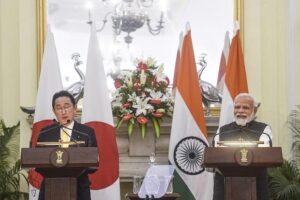



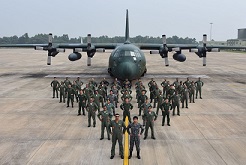



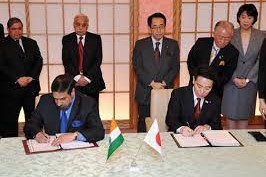

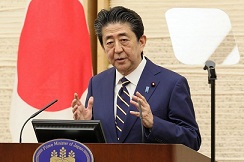
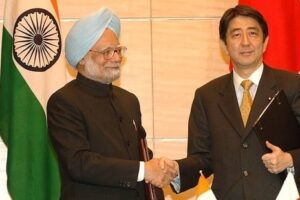

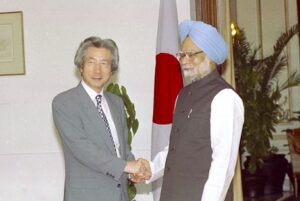
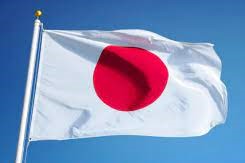
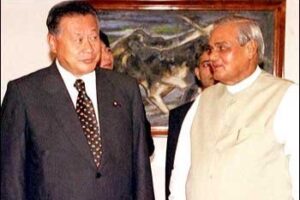





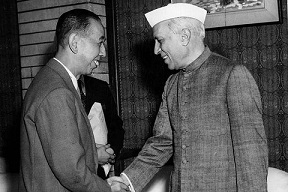



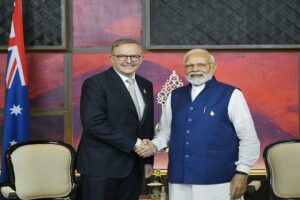



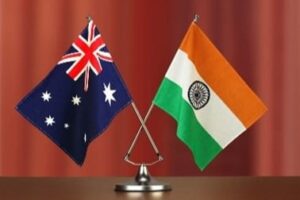
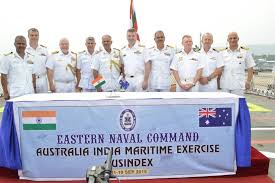

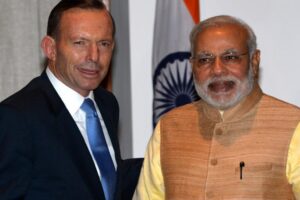





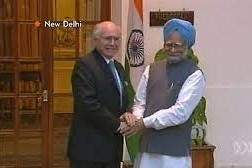
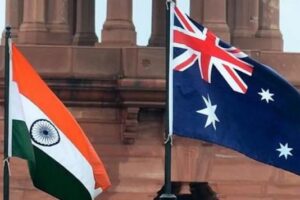
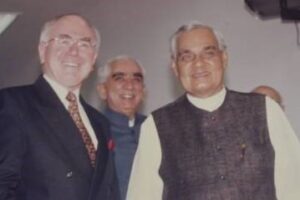

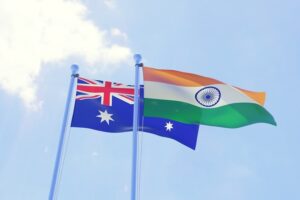

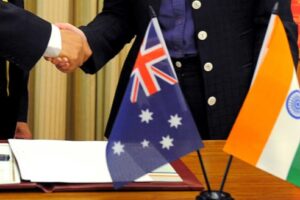

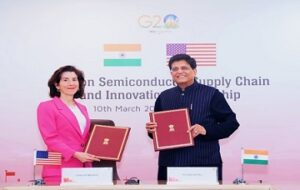
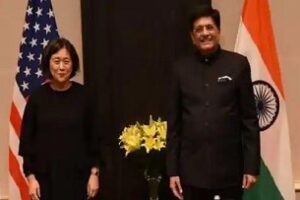
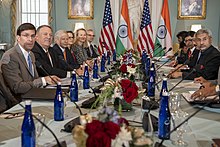

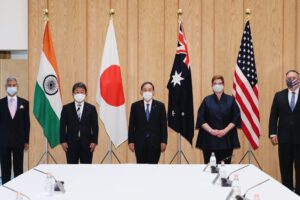

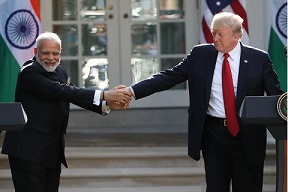
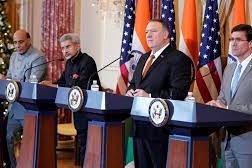

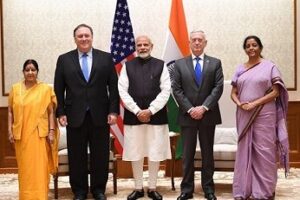
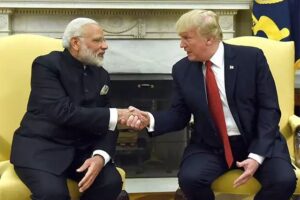
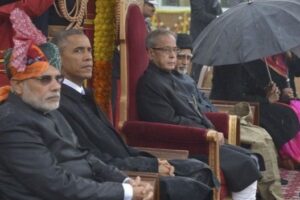

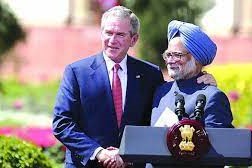
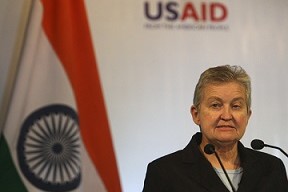
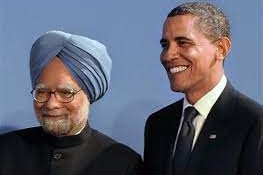
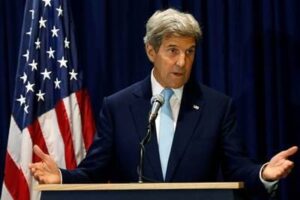

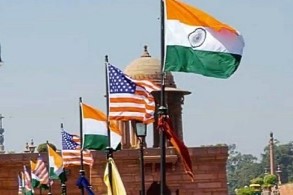
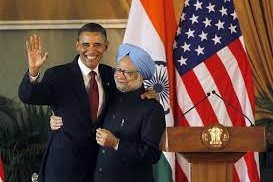
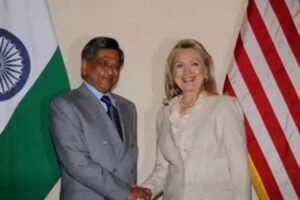
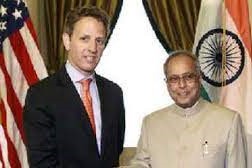
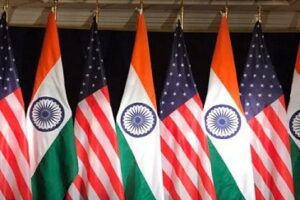
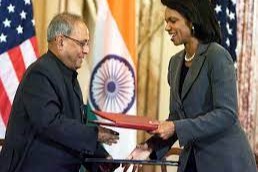

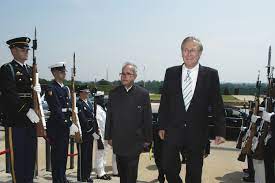




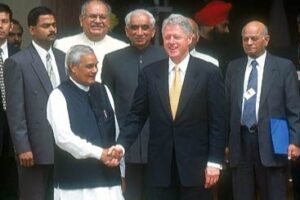


 onducted a total of five underground nuclear tests, breaking a 24-year self-imposed moratorium on nuclear testing. Pakistan followed, claiming 5 tests on May 28, 1998, and an additional test on May 30. The unannounced tests created a global storm of criticism, as well as a serious setback for decades of U.S. nuclear nonproliferation efforts in South Asia. On May 13, 1998, President Clinton imposed economic and military sanctions on India, mandated by Section 102 of the Arms Export Control Act (AECA), and applied the same sanctions to Pakistan on May 30. Some effects of the sanctions on India included: termination of $21 million in FY1998 economic development assistance; postponement of $1.7 billion in lending by the International Financial Institutions (IFI), as supported by the Group of Eight (G-8) leading industrial nations; prohibition on loans or credit from U.S. banks to the government of India; and termination of Foreign Military Sales under the Arms Export Control Act. Humanitarian assistance, food, or other agricultural commodities are excepted from sanctions under the law.
onducted a total of five underground nuclear tests, breaking a 24-year self-imposed moratorium on nuclear testing. Pakistan followed, claiming 5 tests on May 28, 1998, and an additional test on May 30. The unannounced tests created a global storm of criticism, as well as a serious setback for decades of U.S. nuclear nonproliferation efforts in South Asia. On May 13, 1998, President Clinton imposed economic and military sanctions on India, mandated by Section 102 of the Arms Export Control Act (AECA), and applied the same sanctions to Pakistan on May 30. Some effects of the sanctions on India included: termination of $21 million in FY1998 economic development assistance; postponement of $1.7 billion in lending by the International Financial Institutions (IFI), as supported by the Group of Eight (G-8) leading industrial nations; prohibition on loans or credit from U.S. banks to the government of India; and termination of Foreign Military Sales under the Arms Export Control Act. Humanitarian assistance, food, or other agricultural commodities are excepted from sanctions under the law. 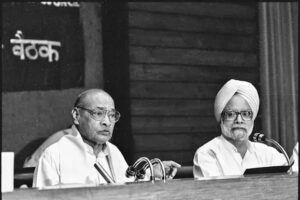
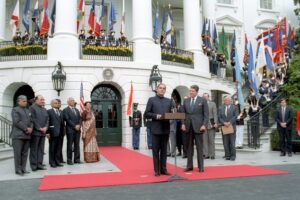

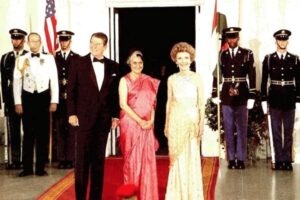

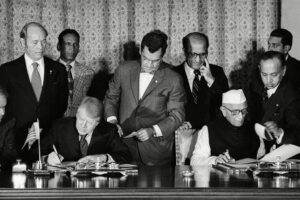
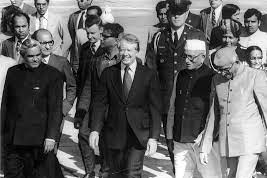

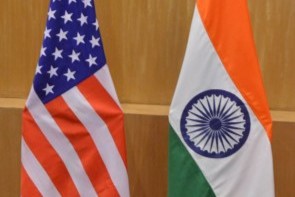



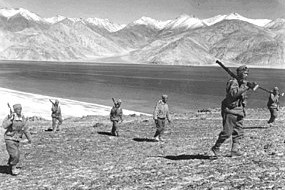

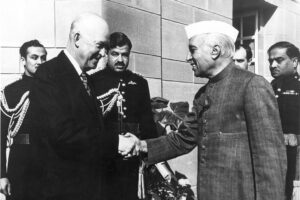

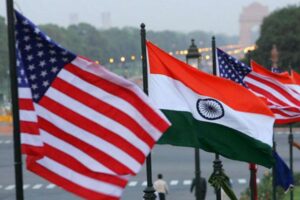
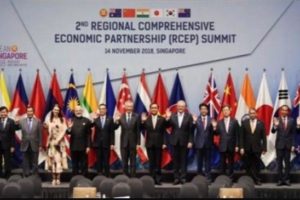 The first ministerial level meeting of QUAD was held on the sidelines of the United Nations General Assembly in New York. Before this, the QUAD had
The first ministerial level meeting of QUAD was held on the sidelines of the United Nations General Assembly in New York. Before this, the QUAD had AusIndEx is an exercise between India and Australia which was first held in 2015.The Australian
AusIndEx is an exercise between India and Australia which was first held in 2015.The Australian 



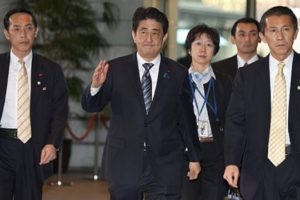



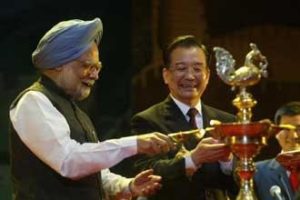 On recommendations of the Japanese government, the four countries met at Manila, Philippines for ASEAN Regional Forum (ARF) originally, but also ended up having a meeting of what we call the first meeting of four nation states on issues of
On recommendations of the Japanese government, the four countries met at Manila, Philippines for ASEAN Regional Forum (ARF) originally, but also ended up having a meeting of what we call the first meeting of four nation states on issues of 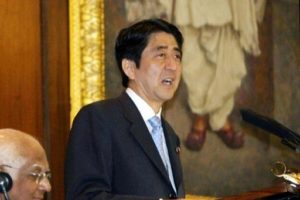 On his official visit to India, Japanese PM Mr. Shinzo Abe reinforced the ties of two nations, i.e., Japan and India with his famous speech about
On his official visit to India, Japanese PM Mr. Shinzo Abe reinforced the ties of two nations, i.e., Japan and India with his famous speech about  In 2007, Japanese President Shinzo Abe resigned from his post citing health reasons. This had a significant impact on QUAD as he was the architect & advocate of QUAD. His successor, Yasuo Fukuda, did not take up QUAD with such zeal leading to dormancy of the forum. (
In 2007, Japanese President Shinzo Abe resigned from his post citing health reasons. This had a significant impact on QUAD as he was the architect & advocate of QUAD. His successor, Yasuo Fukuda, did not take up QUAD with such zeal leading to dormancy of the forum. ( Japan earthquake and tsunami of 2011, also called Great Sendai Earthquake or Great Tōhoku Earthquake, was a 9.0 magnitude earthquake which struck below the floor of the Western Pacific at 2:49 PM. The powerful earthquake affected the northeastern coast of Honshu, Japan’s main island, and also initiated a series of large tsunami waves that devastated coastal areas of Japan, which also led to a major nuclear accident. Japan received aid from India, US, Australia as well as other countries. US Navy aircraft carrier was dispatched to the area and Australia sent search-and-rescue teams.
Japan earthquake and tsunami of 2011, also called Great Sendai Earthquake or Great Tōhoku Earthquake, was a 9.0 magnitude earthquake which struck below the floor of the Western Pacific at 2:49 PM. The powerful earthquake affected the northeastern coast of Honshu, Japan’s main island, and also initiated a series of large tsunami waves that devastated coastal areas of Japan, which also led to a major nuclear accident. Japan received aid from India, US, Australia as well as other countries. US Navy aircraft carrier was dispatched to the area and Australia sent search-and-rescue teams. 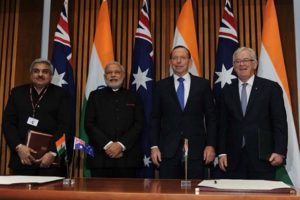 India and Australia signed the
India and Australia signed the  The India-Japan Agreement for Cooperation in the Peaceful Uses of Nuclear Energy was signed on 11 November, 2016 and came into force on 20 July, 2017 which was representative of strengthening ties between India and Japan. Diplomatic notes were exchanged between Dr. S. Jaishankar and H.E. Mr. Kenji Hiramatsu, Ambassador of Japan to India. (
The India-Japan Agreement for Cooperation in the Peaceful Uses of Nuclear Energy was signed on 11 November, 2016 and came into force on 20 July, 2017 which was representative of strengthening ties between India and Japan. Diplomatic notes were exchanged between Dr. S. Jaishankar and H.E. Mr. Kenji Hiramatsu, Ambassador of Japan to India. (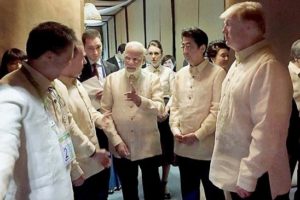 The foreign ministry
The foreign ministry The Officials of QUAD member countries met in Singapore on November 15, 2018 for consultation on regional & global issues of common interest. The main discussion revolved around connectivity, sustainable development, counter-terrorism, maritime and cyber security, with the view to promote peace, stability and prosperity in the
The Officials of QUAD member countries met in Singapore on November 15, 2018 for consultation on regional & global issues of common interest. The main discussion revolved around connectivity, sustainable development, counter-terrorism, maritime and cyber security, with the view to promote peace, stability and prosperity in the  The 23rd edition of trilateral Malabar maritime exercise between India, US and Japan took place on 26 September- 04 October, 2019 off the coast of Japan.
The 23rd edition of trilateral Malabar maritime exercise between India, US and Japan took place on 26 September- 04 October, 2019 off the coast of Japan.  After the first ministerial level meeting of QUAD in September, 2019, the senior officials of US, Japan, India and Australia again met for consultations in Bangkok on the margins of the East Asia Summit. Statements were issued separately by the four countries. Indian Ministry of External Affairs said “In statements issued separately by the four countries, MEA said, “proceeding from the strategic guidance of their Ministers, who met in New York City on the sidelines of the UN General Assembly recently, the officials exchanged views on ongoing and additional practical cooperation in the areas of connectivity and infrastructure development, and security matters, including counterterrorism, cyber and maritime security, with a view to promoting peace, security, stability, prosperity in the Indo-Pacific region.”
After the first ministerial level meeting of QUAD in September, 2019, the senior officials of US, Japan, India and Australia again met for consultations in Bangkok on the margins of the East Asia Summit. Statements were issued separately by the four countries. Indian Ministry of External Affairs said “In statements issued separately by the four countries, MEA said, “proceeding from the strategic guidance of their Ministers, who met in New York City on the sidelines of the UN General Assembly recently, the officials exchanged views on ongoing and additional practical cooperation in the areas of connectivity and infrastructure development, and security matters, including counterterrorism, cyber and maritime security, with a view to promoting peace, security, stability, prosperity in the Indo-Pacific region.” US 2+2 Ministerial Dialogue was held on 18 December, 2019, in Washington DC. Secretary of State Michael R. Pompeo and Secretary of Defense Mark T. Esper will host Indian Minister of External Affairs Dr. S. Jaishankar and Minister of Defense Shri Rajnath Singh. The discussion focussed on deepening bilateral strategic and defense cooperation, exchanging perspectives on global developments, and our shared leadership in the Indo-Pacific region.The two democracies signed the Industrial Security Annex before the 2+2 Dialogue. Assessments of the situation in Afghanistan, Pakistan, Nepal, Sri Lanka, and the Indian Ocean region in general were shared between both countries. (
US 2+2 Ministerial Dialogue was held on 18 December, 2019, in Washington DC. Secretary of State Michael R. Pompeo and Secretary of Defense Mark T. Esper will host Indian Minister of External Affairs Dr. S. Jaishankar and Minister of Defense Shri Rajnath Singh. The discussion focussed on deepening bilateral strategic and defense cooperation, exchanging perspectives on global developments, and our shared leadership in the Indo-Pacific region.The two democracies signed the Industrial Security Annex before the 2+2 Dialogue. Assessments of the situation in Afghanistan, Pakistan, Nepal, Sri Lanka, and the Indian Ocean region in general were shared between both countries. (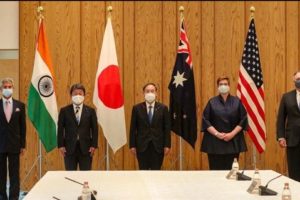 The foreign ministers of QUAD continued their discussions from the last ministerial level meeting in 2019, on 6 October, 2020. While there was no joint statement released, all countries issued individual readouts. As per the issue readout by India, the discussion called for a coordinated response to the challenges including financial problems emanating from the pandemic, best practices to combat Covid-19, increasing the resilience of supply chains, and enhancing access to affordable vaccines, medicines and medical equipment. There was also a focus on maintaining stability in the Indo-Pacific region amidst growing tensions. Australian media release mentions “We emphasised that, especially during a pandemic, it was vital that states work to ease tensions and avoid exacerbating long-standing disputes, work to counter disinformation, and refrain from malicious cyberspace activity. Ministers reiterated that states cannot assert maritime claims that are inconsistent with international law, particularly the United Nations Convention on the Law of the Sea (UNCLOS).”
The foreign ministers of QUAD continued their discussions from the last ministerial level meeting in 2019, on 6 October, 2020. While there was no joint statement released, all countries issued individual readouts. As per the issue readout by India, the discussion called for a coordinated response to the challenges including financial problems emanating from the pandemic, best practices to combat Covid-19, increasing the resilience of supply chains, and enhancing access to affordable vaccines, medicines and medical equipment. There was also a focus on maintaining stability in the Indo-Pacific region amidst growing tensions. Australian media release mentions “We emphasised that, especially during a pandemic, it was vital that states work to ease tensions and avoid exacerbating long-standing disputes, work to counter disinformation, and refrain from malicious cyberspace activity. Ministers reiterated that states cannot assert maritime claims that are inconsistent with international law, particularly the United Nations Convention on the Law of the Sea (UNCLOS).”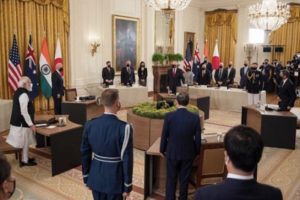 On September 24, President Biden hosted Prime Minister Scott Morrison of Australia, Prime Minister Narendra Modi of India, and Prime Minister Yoshihide Suga of Japan at the White House for the first-ever in-person Leaders’ Summit of the QUAD. The leaders released a Joint Statement which summarised their dialogue and future course of action. The regional security of the Indo-Pacific and strong confidence in the ASEAN remained on the focus along with response to the Pandemic.
On September 24, President Biden hosted Prime Minister Scott Morrison of Australia, Prime Minister Narendra Modi of India, and Prime Minister Yoshihide Suga of Japan at the White House for the first-ever in-person Leaders’ Summit of the QUAD. The leaders released a Joint Statement which summarised their dialogue and future course of action. The regional security of the Indo-Pacific and strong confidence in the ASEAN remained on the focus along with response to the Pandemic. 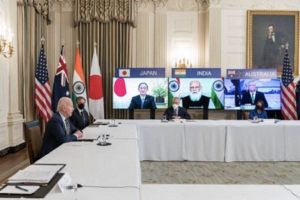 The QUAD Vaccine Partnership was announced at the first QUAD Summit on 12 March 2021 where QUAD countries agreed to deliver 1.2 billion vaccine doses globally. The aim was to expand and finance vaccine manufacturing and equipping the Indo-Pacific to build resilience against Covid-19. The launch of a senior-level QUAD Vaccine Experts Group, comprised of top scientists and officials from all QUAD member governments was also spearheaded.
The QUAD Vaccine Partnership was announced at the first QUAD Summit on 12 March 2021 where QUAD countries agreed to deliver 1.2 billion vaccine doses globally. The aim was to expand and finance vaccine manufacturing and equipping the Indo-Pacific to build resilience against Covid-19. The launch of a senior-level QUAD Vaccine Experts Group, comprised of top scientists and officials from all QUAD member governments was also spearheaded.  Although the Tsunami Core group had to be disbanded on fulfilment of its purpose, however the quadrilateral template that formed remained intact as a successful scaffolding of four countries, as stated by authors Patrick Gerard Buchan and Benjamin Rimland in their diplomatic brief about QUAD ( you can access the brief at
Although the Tsunami Core group had to be disbanded on fulfilment of its purpose, however the quadrilateral template that formed remained intact as a successful scaffolding of four countries, as stated by authors Patrick Gerard Buchan and Benjamin Rimland in their diplomatic brief about QUAD ( you can access the brief at 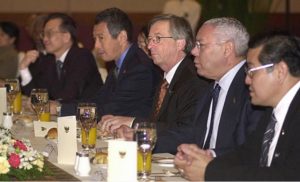 Secretary of State Colin Powell stated that the Core Tsunami Group was to be disbanded and folded and clubbed with the broader United Nations led Relief Operations. In a Tsunami Relief Conference in Jakarta, Secretary Powell stated that
Secretary of State Colin Powell stated that the Core Tsunami Group was to be disbanded and folded and clubbed with the broader United Nations led Relief Operations. In a Tsunami Relief Conference in Jakarta, Secretary Powell stated that 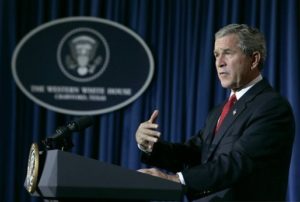 Soon after the Earthquake and Tsunami crisis, humanitarian reliefs by countries, viz., US, India, Japan, and Australia started to help the 13 havoc-stricken countries. The US initially promised $ 35 Millions in aid. However, on 29
Soon after the Earthquake and Tsunami crisis, humanitarian reliefs by countries, viz., US, India, Japan, and Australia started to help the 13 havoc-stricken countries. The US initially promised $ 35 Millions in aid. However, on 29 At 7:59AM local time, an earthquake of 9.1 magnitude (undersea) hit the coast of Sumatra, an Indonesian island. As a result of the same, massive waves of Tsunami triggered by the earthquake wreaked havoc for 7 hours across the Indian Ocean and to the coastal areas as far away as East Africa. The infamous Tsunami killed around 225,000 people, with people reporting the height of waves to be as high as 9 metres, i.e., 30 feet. Indonesia, Srilanka, India, Maldives, Thailand sustained horrendously massive damage, with the death toll exceeding 200,000 in Northern Sumatra’s Ache province alone. A great many people, i.e., around tens of thousands were found dead or missing in Srilanka and India, mostly from Andaman and Nicobar Islands of Indian territory. Maldives, being a low-lying country, also reported casualties in hundreds and more, with several non-Asian tourists reported dead or missing who were vacationing. Lack of food, water, medicines burgeoned the numbers of casualties, with the relief workers finding it difficult to reach the remotest areas where roads were destroyed or civil war raged. Long-term environmental damage ensued too, as both natural and man-made resources got demolished and diminished.
At 7:59AM local time, an earthquake of 9.1 magnitude (undersea) hit the coast of Sumatra, an Indonesian island. As a result of the same, massive waves of Tsunami triggered by the earthquake wreaked havoc for 7 hours across the Indian Ocean and to the coastal areas as far away as East Africa. The infamous Tsunami killed around 225,000 people, with people reporting the height of waves to be as high as 9 metres, i.e., 30 feet. Indonesia, Srilanka, India, Maldives, Thailand sustained horrendously massive damage, with the death toll exceeding 200,000 in Northern Sumatra’s Ache province alone. A great many people, i.e., around tens of thousands were found dead or missing in Srilanka and India, mostly from Andaman and Nicobar Islands of Indian territory. Maldives, being a low-lying country, also reported casualties in hundreds and more, with several non-Asian tourists reported dead or missing who were vacationing. Lack of food, water, medicines burgeoned the numbers of casualties, with the relief workers finding it difficult to reach the remotest areas where roads were destroyed or civil war raged. Long-term environmental damage ensued too, as both natural and man-made resources got demolished and diminished.
No responses yet